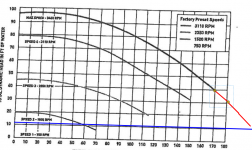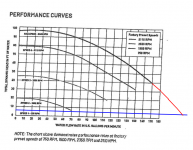I am a plans examiner with our local building department.
My knowledge about residential pools/equipment is VERY limited and I am trying to learn.
The key item have been asked to look at is the main drain - and how it is sized to "keep up" with the maximum speed of the pump given the calculated TDH. (most contractors use the simplified TDH)
I've been instructed to take the calculated simplified TDH, use the performance curve for the pump and the max speed of the pump to check the size of the main drain that has been specified. The curve below shows data from an application with a TDH of 10.6 and a drain with gpm of 150. The way it has been explained to me - based on the calculation - the main drain is not sufficient.
Does this sound correct?
THANKS in advance for anyone willing to help.

My knowledge about residential pools/equipment is VERY limited and I am trying to learn.
The key item have been asked to look at is the main drain - and how it is sized to "keep up" with the maximum speed of the pump given the calculated TDH. (most contractors use the simplified TDH)
I've been instructed to take the calculated simplified TDH, use the performance curve for the pump and the max speed of the pump to check the size of the main drain that has been specified. The curve below shows data from an application with a TDH of 10.6 and a drain with gpm of 150. The way it has been explained to me - based on the calculation - the main drain is not sufficient.
Does this sound correct?
THANKS in advance for anyone willing to help.




